
Exciting Introduction: How to Cultivate Extraordinary Power
Section One: Key Principles of Qi Gong Practice
Martial Arts Manual: Shaoshi (Shaoshi Mountain) Long Lantern Bright Four Seasons, Zen Shadow Accompanies Lantern Reliant on True Qi. Valley Water Can Only Moisten the Skin, Only the Zong Qi (Vital Qi) Maintains Body Strength. The Three Marvels of Qi Gong Practice: One is Stillness, Two is Relaxation, Three is Uniformity and Fineness. Stillness is the Mind Empty Alone, All Things Sink Like Stones to the Bottom of the Sea. Relaxation is to Release Muscles Like Flowing Sand, Blood Follows Qi Flowing Slowly Down. Breathing Deep, Long, Fine, and Uniform, Length and Shortness Equal Without Error.
The Shaolin Monks’ Ancestors, through over a thousand years of research and practice, have accumulated rich experience. Shaolin Qi Gong integrates martial arts with Qi, distinguishing it from other schools. For example, during the late Yuan and early Ming dynasties, the monk Jin Naluo was skilled in staff techniques, capable of defeating countless fierce generals with a single firewood stick, renowned throughout the Central Plains. Jin Naluo Wang used Qi to empower his staff, and it was said that when his staff was unleashed, it spun around him like a fire line, impervious to water and arrows. This is the fruit of Qi Gong’s power. The basic principles of initial Shaolin Qi Gong practice are five: One is Stillness, Two is Relaxation, Three is Uniformity and Fineness, Four is Persistence, Five is Three Practices.
1. Stillness: This refers to complete concentration of thought during Qi Gong practice. An ancient saying goes, “Do not look at the fairy walking in front, do not think of the dragon playing outside the door, do not fear the golden knife taking your head, as if you are alone walking in the deep mountains.” Specifically, it means to eliminate all external distractions during practice, allowing the mind to concentrate and the brain to truly maintain “stillness.” The method is to focus on the “Dan Tian” (丹田, Dantian: the energy center located three inches below the navel), as the Dan Tian is the gathering place of Qi. Ancient texts say: “The Dan Tian is the sea of Qi, capable of swallowing a hundred diseases.” Therefore, focusing on the Dan Tian is the primary secret and principle of Qi Gong practice. The martial arts manual states: “The tongue touches the upper palate to gather Qi, Qi enters the Dan Tian to form divine power.” During Qi Gong practice, one must focus on the Dan Tian and press the tongue against the upper palate (the tip of the tongue rolls up to touch the palate), gathering Qi to the mind. This prevents the body’s essence, Zong Qi, and Wei Qi from dispersing. The Inner Canon states: “Qi is the commander of blood, blood is the mother of Qi.” When Qi flows smoothly, blood circulates freely; when blood is strong, Qi is robust. In summary, blood is the strength of Qi, and Qi guides blood. This is especially true for Qi Gong. Gathering Qi means gathering strength, releasing Qi means exerting force; when Qi arrives, strength arrives; Qi is essence, Qi is strength.
The above methods of practicing Qi Gong are easy to do but difficult to master for beginners, mainly because it is hard to enter a state of stillness and concentrate the mind at the beginning. However, the masters have left us valuable experiences, such as “silent counting,” which means counting silently from one to ten, then from ten to a hundred, and from a hundred to a thousand, generally counting to about ten thousand: repeated counting over time will yield good results, and the mind will concentrate. Alternatively, one can count breaths, treating each inhalation and exhalation as one breath, counting breaths from one to ten, from ten to a hundred, even to a thousand or ten thousand. With persistent practice, the mind will concentrate. The ancients said: “Stillness comes from pure thought,” and when thoughts are concentrated, the mind is “still.”
2. Relaxation: This means to relax all the muscles of the body. The martial arts manual states: “Relaxation allows Qi to reach, Qi must be sufficient before it can be stored.” In martial arts combat, to deal with various attacks, one must use different parts and methods to counterattack, sometimes using fists, sometimes feet, which requires adjusting Qi. From top to bottom, or from bottom to top, or from left to right, or from right to left, this transition is called changing Qi. Before changing Qi, one must first relax; if one does not relax, it is difficult to move; only by relaxing can Qi flow smoothly. Changing Qi means coming, changing Qi means going. This is the role of relaxation in Qi Gong.
3. Uniformity and Fineness: This refers to making breathing deep, long, fine, and uniform during Qi Gong practice. The martial arts manual states: “Breath descends to the soles of the feet, rises to Kunlun (Kunlun Mountain).” One must exhale fully when exhaling, and inhale fully when inhaling, and it must be fine and uniform. One cannot suddenly be coarse, then fine, suddenly long, then short. It must be uniform in thickness and length, and it is crucial not to have long inhalations and short exhalations, or long exhalations and short inhalations.
4. Persistence: This means to practice consistently. The essence of Qi Gong lies in persistence, regardless of the biting cold of winter or the scorching heat of summer; regardless of illness or environmental difficulties, one must practice diligently and persistently. Throughout the four seasons, practice should be consistent, for decades as if it were a single day; life does not stop, and practice should not cease. One must persist and not have one day of exposure followed by ten days of cold.
5. “Three Practices”: This means practicing in the morning, practicing under the stars, and practicing at noon, three times a day. The martial arts manual states: “Morning practice releases waste and takes in new Qi, noon practice harmonizes and stores vital Qi, deep night practice releases Qi and sharpens vitality, fingers can pierce wood like inserting a mat.”
Morning practice: After a day of activity and metabolism, waste accumulates overnight while lying down. Therefore, morning Qi Gong practice can stretch the muscles and bones, release waste, and take in new energy, revitalizing the organs and spirit.
Noon practice: After half a day’s activity (both physical and mental), Qi can become reversed, losing stillness and becoming scattered and weak. Therefore, noon practice can adjust Qi back to the center, promoting stillness and harmony. However, the noon practice should not be too long, generally 10-15 minutes is sufficient.
Starry night practice: Also known as deep night practice, this is when the stars are fully out, and the night is quiet, beginning practice. The ancients said: “Morning is new, noon is stored, night is waste, returning to sharpness.” Morning practice expels waste and takes in new energy; noon practice adjusts and stores the sharpness of half a day; starry night practice: all things are immersed, thoughts are pure, the heart is focused, and Qi should be led out. It is most suitable to practice “Tian Zhu” (顶天柱, Ding Tian Zhu: a practice where one balances a brick or wooden board on the head), gradually increasing weight and length, with persistent practice one can support a thousand pounds. One can also practice finger piercing wood (using the index finger to pierce through soil, cotton, walls, and with time can pierce wood), as well as one-finger gold, diamond fist, etc.
Martial Arts Manual Qi Movement Song
Qi emerges from the Dan Tian, hands lift the Yin,
Qi rises as hands tighten against the body,
To the mouth, hands flip, following Qi release,
Qi returns as hands grasp, steps are preserved.
Explanation: Every morning, facing the sun, take three deep breaths, then circulate Qi. Lower it to the soles of the feet, raise it to Kunlun. The movements of hands and feet, the body’s left and right turns, rising and falling, open and close, all form one Qi, the body moves, and the hands and feet connect. It is also necessary to clarify the position of the eyes, distinguish the grip, connect with breathing, and move as needed. The essence of Qi movement lies in slowness, while the use of Qi lies in urgency; taking away is suitable for exhaling, receiving is suitable for inhaling; the body rolls to move, hands roll to release Qi; striking without visible shadow, must be in urgency. The profound principles lie in each breath.
Note: At four in the morning, quickly rise, face southeast, and take deep breaths. Three exhales and three inhales release waste, expelling the old and taking in the new to open the lungs. When exhaling, lift the heels, extend arms forward. When inhaling, expand the chest and open the lungs, heels touch the ground, arms spread. When exhaling, extend the chest forward and lean back, joints and muscles stretch tight. When moving, the tongue touches the upper palate, gathering Zong Qi at the valve. Qi rises to Kunlun Peak, slowly descends to the soles of the feet. Rising and falling, opening and closing, all connect as one Qi, up and down, left and right tightly attached to the body. Qi emerges from the Dan Tian to the fingertips, Qi returns to the lungs, hands and feet tighten. Hands roll out, Qi flows, body rolls to store Qi. The beauty of Shaolin Qi Gong lies in practice; with long practice, the skill deepens, pushing mountains and rolling.
Section Two: Specific Methods of Internal Skills
1. Sitting Posture
1. Upright Sitting: Sit on a stool or chair, with knees bent at ninety degrees, feet flat on the ground, hands naturally resting on thighs, upper body straight, not leaning forward or backward, or tilting left or right, eyes slightly closed, gaze at the tip of the nose, concentrate the mind, and focus on the Dan Tian. Start with 30 minutes, gradually increasing to one hour (Figure 1).
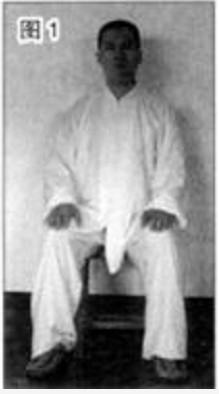
2. Single Leg Cross: Sit cross-legged on a bed, kang, or wide wooden surface, placing the left foot on the upper part of the right knee, with the left ankle bone facing down, foot sole to the right, toes forward. The outer knee of the left leg and the outer knee of the right leg touch the bed or ground simultaneously, hands resting on the abdomen, right palm on top, left palm below, thumbs extended, the other four fingers together, resembling the Amitabha mudra. Eyes slightly closed, gaze at the tip of the nose, tongue against the upper palate, mouth naturally closed, breathing through the nose. Initially practice for half an hour, gradually extending to two hours. The best time is after midnight when all is quiet (Figure 2).
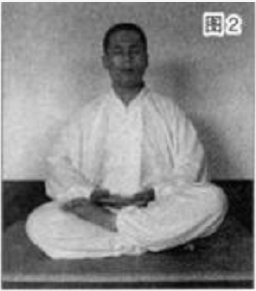
3. Double Leg Cross: Sit on a mat or bed, with both legs bent and crossed, sitting upright.This method is more difficult and is generally practiced after one year of diligent practice in the single leg cross.The crossing method is: after sitting down, first lift the right foot, placing the right ankle on the upper part of the left knee; then lift the left foot, placing the left ankle on the inner side of the right knee, crossing the legs, with the soles of the feet facing outward and toes forward.Keep the upper body straight, eyes slightly closed, gaze at the tip of the nose, tongue against the upper palate, mouth naturally closed, breathing through the nose.Relax the waist, with both hands pressing down on the thighs, resembling the Amitabha mudra.Qi emerges from the Dan Tian, rising to Baihui (百会, Baihui: the crown point), descending to the back, splitting into two paths, flowing down the outer sides of the hips, then returning to the Dan Tian, slowly reaching Kunlun, and finally reaching the soles of the feet.Then return to the Dan Tian (Figure 3).
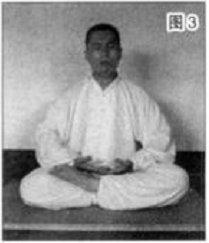
4. Flower Insertion Style: Sit in a wide, flat area, crossing the legs (left foot outside), with the soles of the feet facing outward and toes forward.Keep the upper body straight, not leaning forward or backward, or tilting left or right.Place both palms stacked on the thighs, thumbs extended, palms facing up, resembling both hands holding a seal.Eyes slightly closed, gaze at the tip of the nose, tongue against the upper palate, mouth naturally closed, breathing through the nose.Practice for about half an hour, with the best times being around 5 PM and deep night when all is silent.This method is relatively easy to practice, and many people are familiar with it (Figure 4).
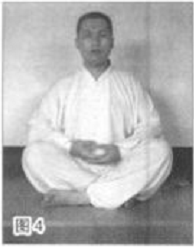
2. Standing Posture
Three Circles Style: The three circles refer to the hand circle, foot circle, and hip circle. Stand with feet shoulder-width apart, toes slightly inward. Raise both hands to shoulder height, fingers naturally spread, palms facing each other, resembling holding a ball, about a foot apart, then both hands slowly lower to the sides, resting on the lower abdomen, palms touching, palms facing inward. Keep the body upright, not leaning forward or backward, or tilting left or right. Eyes slightly closed, gaze at the tip of the nose. Concentrate the mind, and focus on the Dan Tian (Figure 5).
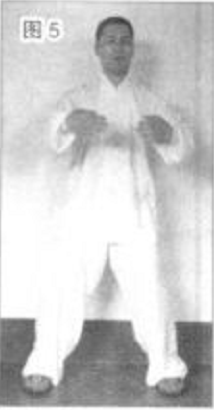
3. Lying Posture
1. Supine: Lie on the bed, legs naturally extended, toes naturally pointing outward, the whole body lying straight, hands flat on the outer sides of the thighs, touching the bed. Palms facing down, fingers slightly bent, eyes slightly closed, gaze at the tip of the nose. Tongue against the upper palate, mouth naturally closed, breathing through the nose (Figure 6).
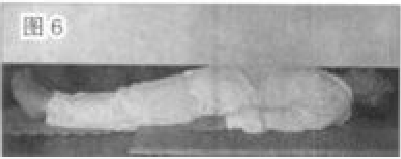
2. Side Lying: Lie on the side, generally with the right side down, knees bent forward (forming an obtuse angle), the right leg touching the bed, the left leg slightly raised, resting on the right ankle.Place both hands in front of the body, right palm facing up, left palm facing down on the bed, head slightly forward, resembling a praying mantis.Eyes slightly closed, gaze at the tip of the nose, tongue against the upper palate, breathing through the nose.This method is easy to master and conducive to sleep.Practice for half an hour, which has significant effects on treating heart disease and neurological disorders (Figure 7).
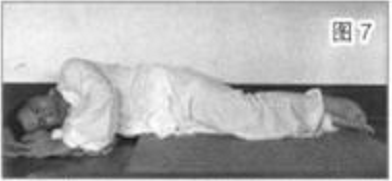
Section Three: Moving Qi to the Dan Tian
Moving Qi is also called using Qi. The process of moving Qi begins with changing Qi, then leading Qi with intention, sinking to the Dan Tian (where all Qi converges), and finally releasing Qi, which means exerting force. The stillness in internal skills is leading Qi with intention, moving slowly like an ant crawling. In external skills, it is bursting Qi, meaning exerting force. The fusion of Qi and strength is Qi Gong.
1. Changing Qi: Also called expelling the old and taking in the new, it is the preparatory work for practicing Qi Gong. Every morning around five o’clock, rise, go to a place with fresh air, face southeast, stand upright with feet in a V shape. First, move the head and neck, then move the limbs, waist, knees, and other joints for a moment, then separate the hands from the chest, drawing arcs outward, upward, and forward. At the same time, begin to inhale; when the hands are level with the shoulders, extend the elbows backward to expand the chest. When the arms stretch above the head, lift the heels off the ground, forcefully inhaling the last breath. Then, slowly lower the hands from above the head forward and downward, while the upper body slowly leans forward, forcefully inhaling. When the hands drop past the knees, interlock the palms and fingers, pressing down as much as possible, so that the palms touch the ground, keeping the knees straight, forcefully inhaling the last breath. Then, release the hands, slowly drawing arcs upward, beginning to inhale, and slowly straighten the upper body. Repeat this process of rising to inhale and bending to exhale five to seven times.
This process is called changing Qi, which is expelling the old and taking in the new. Whether practicing internal skills, martial arts, or light skills, one must first learn and practice changing Qi. Although this action is simple and easy to learn, it is a crucial step in Qi Gong. Changing Qi is not only the foundation of Qi Gong but also an eternal skill, to be practiced daily, yearly, and throughout one’s life.
2. Qi Gathering in the Dan Tian Practice:
Martial Arts Manual: The Dan Tian is located three inches below the navel, in the center. Change Qi five to seven times, focusing on the Dan Tian. Regulate breathing to gather Qi, the source of strength is in the Dan Tian. Intention leads to the four extremities, a thin man can carry Mount Tai. Four ounces can move a thousand pounds, the Dan Tian is the source of strength.
Note: The Dan Tian is located three inches below the navel, in the center.
Every morning during Qi Gong practice, one should first change Qi, then stand upright, or practice in a bow stance or horse stance. Begin by leading Qi with intention, adjusting breathing with intention at all times, focusing on the Dan Tian.
Lead Qi with intention, allowing Qi to sink to the lower abdomen, which is called “Qi sinking to the Dan Tian.”
Lead Qi with intention, concentrating the mind, contracting the lower abdomen, allowing Qi to gather in the center of the lower abdomen, preparing to release, which is called “Qi gathering in the Dan Tian.”
Lead Qi with intention, combining with relaxing the abdomen, creating a sensation of electric heat, releasing strength as it moves, which is called “Qi releasing from the Dan Tian.”
The method of the Dan Tian is the mother method of Qi Gong, and the Qi of the Dan Tian is the source of tiger strength. When practicing this method, remember to be patient; persistence will surely lead to success.
3. Qi Releasing from the Dan Tian (also called releasing Qi): Lead Qi with intention, allowing Qi to sink to the Dan Tian, gradually gathering it there. Contract the abdomen to store true Qi and essence. Then, with movement, release quickly, bursting forth from the Qi of the Dan Tian. “Bursting” also means exerting force; if moving right, the bursting force quickly reaches the right; if moving left, the bursting force quickly reaches the left; if moving up, the bursting force quickly goes up; if moving down, the bursting force quickly goes down; when the whole body moves together, the bursting force is like a volcanic eruption, rapidly reaching all joints, like thunder, fast as lightning.
Movement and bursting should be released simultaneously, with careful coordination, and only through long practice will results be seen. Initially, move the hands, then the feet; after several months, move the legs, elbows, and knees; then practice the body, jumping, and those who practice for a long time will gain great strength, gradually practicing hand insertion into sand, palm splitting bricks, fingers piercing walls, diamond fists, and one-finger gold, etc. Then practice foot skills, leg skills, such as wearing iron tiles, wrapping sandbags. Jumping and leaping, naturally, success will come easily.
4. The Medical and Health Benefits of Qi Gong: Centuries of practice have proven that whether external or internal skills, the aim is to adjust the human body, normalize its functions, and balance Yin and Yang, achieving the goal of unblocking meridians, regulating Qi and blood, balancing Yin and Yang, allowing Zong Qi, Wei Qi, and true Qi to be abundant, resulting in a naturally flexible and strong physique, vibrant and energetic, thus promoting longevity. Moreover, it can also prevent and treat some chronic diseases, such as hypertension, heart disease, diabetes, chronic gastritis, liver cirrhosis, eye diseases, mental illnesses, neurasthenia, hysteria, and post-concussion syndrome.
Disclaimer
The article only represents the author’s personal views and does not reflect the position of this public account..
We respect originality; the copyright of the article belongs to the original author. Some articles may not have been able to contact the original author for various reasons when pushed, and if there are copyright issues, please contact us for immediate handling. We are grateful to the original author for their hard work and sharing!



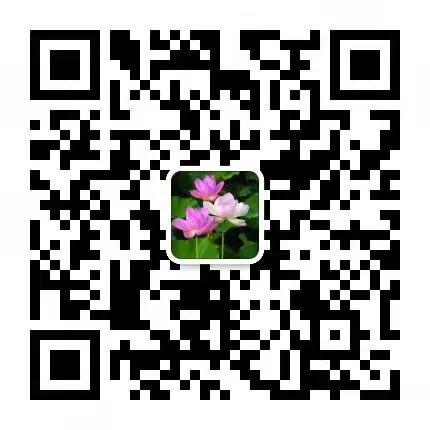 WeChat ID: shengxinxing999
WeChat ID: shengxinxing999
Long press to identify and contact us

